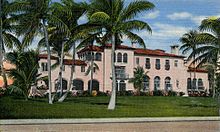Edward T. Stotesbury

Edward Townsend "Ned" Stotesbury (February 26, 1849 – May 16, 1938) was a prominent
Early life and first marriage
Stotesbury was born in
Career


Stotesbury got his start working for Drexel & Co., the well-known Philadelphia banking house founded by
One of the significant services which he performed in the course of his business career was assisting in the floating of the International Chinese Loan of 1909. He was a director of the
Second marriage and later career

On January 18, 1912, after having been a
The couple's first project together was redecorating his Philadelphia townhouses at 1923–25 Walnut Street.[3] They went on to build three palatial estates:
- Whitemarsh Hall outside Philadelphia by architect Horace Trumbauer (1916–21, demolished 1980)
- El Mirasol in Palm Beach, Florida by architect Addison Mizner (1919, demolished 1950s)
- Magaziner, Eberhard & Harris (1927, demolished 1953)[4]
In 1927, Stotesbury's fortune was estimated at $100 million ($1.8 billion today). While he withdrew $55 million from his J.P. Morgan account during the Great Depression,[5] the stock market crash and the depression further drained the value of his fortune, leaving him with an estimated $4 million ($100 million today) at the time of his death in 1938.
Stotesbury died at eighty-nine on May 21, 1938, in
Legacy
Every year since 1927, the
The Stotesbury Club House, a building on Stotesbury's equestrian farm in Wyndmoor, Pennsylvania, was listed on the National Register of Historic Places in 1985.[7]
Edward and Eva Stotesbury are characters in the Stephen Sondheim musical Road Show (2008).
The land on which Whitemarsh Hall was built was developed into a town house complex named after Stotesbury.
Family
Stotesbury's second daughter, Edith Lewis Stotesbury (April 3, 1877 – 1935), married Sydney Emlen Hutchinson on December 25, 1903. His third daughter, Frances Butcher Stotesbury (November 7, 1881 – October 14, 1950), married John Kearsley Mitchell on January 5, 1909.
On February 14, 1922, his stepdaughter, Henrietta Louise Cromwell, a divorcee with two children, married General of the Army Douglas MacArthur. They divorced in 1929.[8]
His stepson,
References
- ^ "Friendly Hands Are Extended," The Peircetonian,(Philadelphia, PA), September 1939.
- ISBN 978-1-59213-988-0.
- ^ The townhouses, at the NE corner of 20th & Walnut Sts., were designed by architect Frank Furness for client Thomas McKean and his son in 1869.[1] Archived August 21, 2009, at the Wayback Machine
- ^ Postcard of Wingwood House
- ^ Peg Brickley (January 10, 2000). "Wealth and folly and more". Philadelphia Business Journal.
- ^ Kenny, Hamill (1945). West Virginia Place Names: Their Origin and Meaning, Including the Nomenclature of the Streams and Mountains. Piedmont, WV: The Place Name Press. p. 605.
- ^ "National Register Information System". National Register of Historic Places. National Park Service. July 9, 2010.
- ^ William Manchester, American Caesar: Douglas MacArthur 1880–1964, Little, Brown & Company (1978), p. 141
